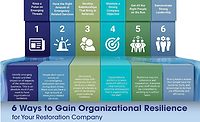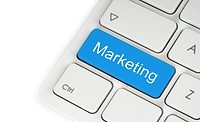6 Ways to Increase Cash Flow in Your Restoration Company

The answer to this question is one that has haunted small business owners: cash flow. A company can look good on paper, bringing in consistent revenue and new clients, while still coming up short at the end of the month. This phenomenon ties back to cash flow: the flow of money coming into and going out of the business. When more money goes out of the business each month than comes in, the business has negative cash flow. Here are some ideas to turn your business into a cash generating machine!
1. Increasing the sale of goods and services
The first place most of us think about is increasing sales. Adding more customers, picking up additional contracts, and providing add-on services are all means of increasing the amount of income the business receives. With that said, remember that only the net profit from those additional sales translates into additional cash in your bank account. There are a lot of hidden costs associated with increased sales that can result in less cash than you were hoping for. Remember, increasing sales by $100 may only increase your net profit $30, after deducting the additional costs that generated the additional $100 in sales. Operating Costs such as labor costs, material costs, gas, equipment maintenance costs and the like all reduce the amount of each sale that ends up in your bank account.
2. Reducing operating costs
A more powerful and direct way to put cash in your bank account is to reduce your operating costs. When you reduce your operating costs by $100, 100% of the benefit drops to the bottom line and your bank account grows by $100! With a little thought and creativity, you will be amazed at what you can accomplish. Less money goes out, more money stays in, and the cash flow into the bank account goes up!
3. Reducing Accounts Receivable
The term “Accounts Receivable” can be a dirty word for some businesses. Reducing your level of Accounts Receivable by $100 increases your cash flow into your bank account by… you guessed it… $100. On the flip side, if you allow your Accounts Receivable to grow you could find yourself in a cash flow death trap. Let me illustrate this with an example: Suppose you increase sales by $100 for which you have $70 worth of expenses. You calculate your profit on the sale to be $30. What is your cash flow? The answer is negative $70! What?... how can that be? You must remember that not only will you not collect the $100 sales price for 120 days, but you will have to immediately pay the $70 worth of expenses it took to generate the sale. Certainly, you will ultimately have a positive cash flow of $30. But here is the problem: cash flow determines how much cash is in your bank account TODAY and if you don’t manage your cash flow well in the short run, you may not get to enjoy it in the long run.

4. Extending your Accounts Payable
Ah… here is an idea for you to use the principles of cash flow to your advantage. If growing your Accounts Receivable takes cash out of your pocket, then growing your Accounts Payable puts cash into your pocket. Essentially, you are getting a cash loan from your suppliers. So, to the extent you can, take advantage of establishing and extending your credit account with your suppliers. Consider it a 0% loan that offsets the negative effects of Accounts Receivable and provides a welcomed addition to your working capital.
5. Buying and selling assets
Selling a piece of equipment is a way to free up cash. Because buying and selling assets does not show up on your P&L (Profit and Loss Statement), it is often forgotten as a major source or use of cash. Similar to growing your Accounts Receivable, buying equipment or vehicles creates a major drain on cash flow and can offset the cash that you bring into the business through the profit shown on your P&L.
6. Increase your cash flow by financing income producing assets
While buying assets uses up precious cash flow, it is imperative that your business acquires the equipment and vehicles it needs to grow. You can have your cake and eat it too when you finance income producing assets. A recent survey showed that nearly 80% of corporate businesses plan on financing new equipment in 2018. Financing equipment spreads the cost of purchasing equipment across the time that the equipment will be used to produce income. This idea of matching the cash “outflow” of purchasing the equipment with the cash “in-flow” of operating the equipment to produce income is an important strategy for businesses that want to grow.
When talking about improving the cash flow health of a business, most owners use a combination of the techniques discussed above. Understanding and effectively using these tools can be as much of a competitive advantage as having a great marketing strategy. Consult your financial advisor to get a cash flow checkup and discover ways you can make a difference in the health and flexibility of your business today.
Looking for a reprint of this article?
From high-res PDFs to custom plaques, order your copy today!








